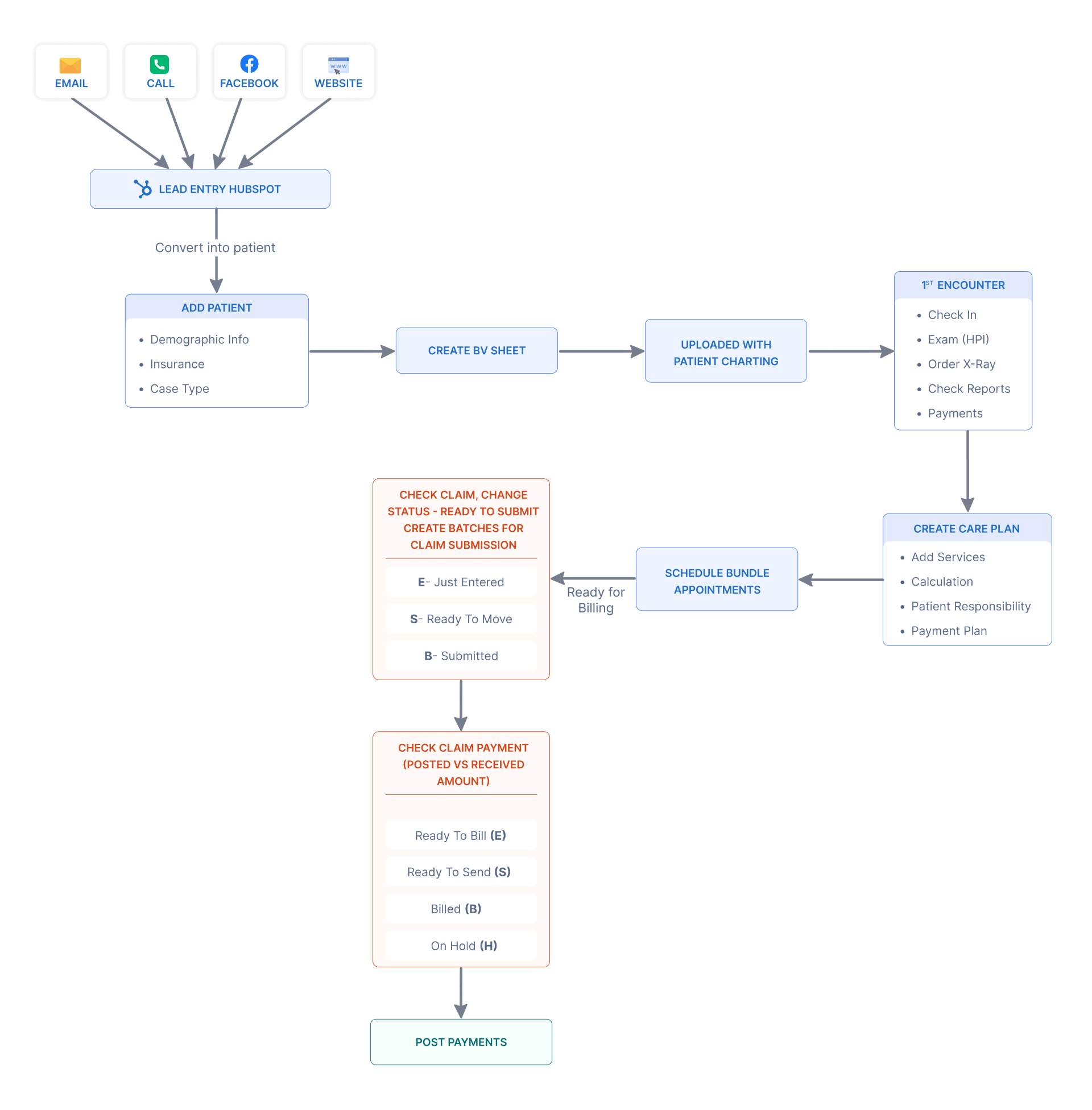Overview
Our client, a leading orthopedic clinic in the US, is renowned for its exceptional care and treatment of orthopedic conditions. With a team of dedicated healthcare professionals, they offer a comprehensive range of services from diagnosis to treatment. Driven by a commitment to excellence, the clinic is known for its personalized approach to patient care.
However, the clinic's operations were hindered by a fragmented workflow, which resulted from relying on multiple systems for essential tasks. Recognizing the need to streamline operations and elevate patient care, the client seeks a custom EHR software with advanced features that caters to their unique requirements.
Business challenges
The client's clinic operates with a highly fragmented workflow involving manual processes and multiple systems:
1. Fragmented Workflow:
Essential tasks like appointment scheduling, patient intake, insurance verification, care plan development, and billing rely on multiple, unconnected systems. This disrupts workflows, hinders information flow, and increases administrative burden.
2. Poor Appointment Management:
Patient appointment requests are received through the clinic's website, and the front desk manually handles these requests from a third-party lead management system, HubSpot.
3. Manual Data Entry:
Manual entry of patient information across various systems is time-consuming, prone to errors, and leads to data inconsistencies.
4. Limited Visibility:
The lack of a central platform made obtaining a holistic view of each patient's journey difficult, impacting care coordination and decision-making.
5. Inefficient Communication:
Communicating with patients and insurance providers requires switching between systems, which can result in delays and potential misunderstandings.
Client Needs
To address these challenges, the client sought an advanced EHR system with the following functionalities:
1. Automated Lead Capture:
Seamless integration with HubSpot to automatically capture patient appointment requests from the website.
2. Interactive Dashboards:
Patient listing with color-coded status indicators (e.g., new, contacted, scheduled) for efficient patient management.
3. Patient Charting with Contact Log:
A centralized location to capture patient interactions, including notes, phone logs, and appointment details.
4. Integrated Claim Management:
Streamlined insurance verification, benefit checks, and claim submission capabilities.
5. Communication Module:
A secure messaging platform for communication with patients and internal teams to improve care coordination.

Solution
We implemented a robust, all-encompassing EHR system specifically designed for orthopedic practices. Here's how it addressed the client's needs:
1. Automated Lead Capture:
The system utilizes APIs provided by HubSpot to establish a seamless integration, allowing for real-time data exchange between the EHR system and HubSpot. Upon receiving appointment requests, the EHR system automatically captures relevant patient details, such as name, contact information, and appointment preferences, eliminating manual data entry. This integration leverages data mapping techniques to ensure the accurate transfer of information, reducing the risk of errors and enhancing operational efficiency.
2. Interactive Dashboards:
Interactive dashboards are crafted using modern visualization tools, presenting patient data in real time with color-coded indicators. Real-time overview improves decision-making and prioritization. Interactive elements enable the front desk team to quickly identify patient statuses and take appropriate actions, leading to optimized scheduling and improved patient management.
3. Patient Charting with Contact Log:
We have developed a module for patient charting in which patient information is centralized in a structured database, accessible through a user-friendly interface. A centralized patient chart houses comprehensive patient information, including demographics, medical history, progress notes, phone logs, and appointment details. This integrated repository facilitates seamless care coordination among healthcare providers, ensuring informed decision-making and personalized patient care.
- Demographics (name, address, date of birth)
- Medical history (diagnoses, allergies, medications)
- Progress notes (physician notes after each visit)
- Imaging reports (X-rays, MRIs)
- Lab results
- Contact Log (detailed record of all communication with the patient, including phone calls, emails, and in-person interactions)
- Appointment details
4. Claim Management:
The developed system seamlessly integrates insurance verification and benefit checks, automating the generation of accurate claims codes and co-pay estimates. Electronic claim submission expedites reimbursement processing, reducing administrative burden and improving financial efficiency for the clinic.
- Insurance Verification: Quickly verify patient insurance coverage and eligibility for specific services.
- Benefit Checks: Access real-time information on patient benefits, including co-pays, deductibles, and coverage limits.
- Automated Claim Generation: Based on patient details, service codes, and insurance information, the system can automatically generate accurate claim forms.
- Electronic Claim Submission: Submit claims electronically to insurance companies for faster processing and reimbursements.
Value Delivered
By implementing a unified EHR system, the client achieved significant improvements:
-
Improved Workflow Efficiency:
Automated data capture, interactive dashboards, and integrated functionalities eliminate the need for multiple systems, streamlining workflows and reducing administrative burden.
-
Enhanced Data Visibility:
Real-time access to patient information empowers providers to make informed decisions regarding treatment plans.
-
Reduced Errors:
Automated features and centralized data management minimize data entry errors and inconsistencies.
-
Improved Patient Satisfaction:
Streamlined scheduling, transparent communication, and easier access to patient information enhance patient experience.
-
Increased Revenue:
Faster claim turnaround times and efficient billing processes lead to improved cash flow.
